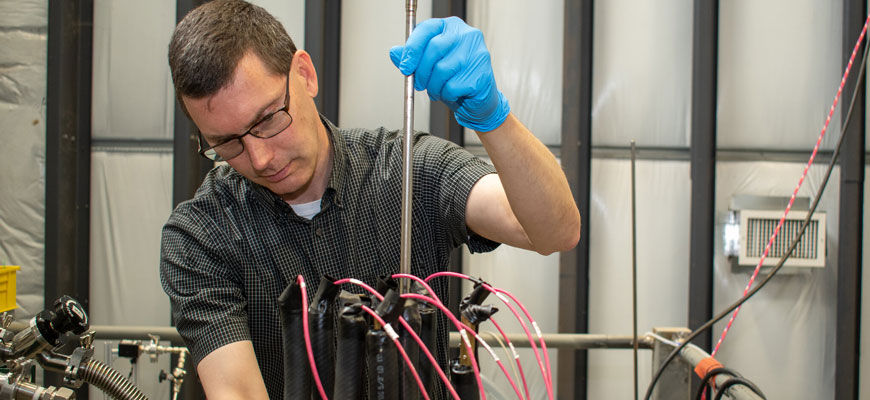According to the Office of Nuclear Energy, the U.S. generates approximately 2,000 metric tons of spent (used) nuclear fuel each year and approximately 83,000 metric tons has been produced since the 1950s. The spent fuel is stored at more than 70 sites in 34 states, primarily at the same location as nuclear power plants, such as the Savannah River Site in southwestern South Carolina.
While the current storage method is considered safe, Mechanical Engineering Professor Travis Knight recently began research on utilizing sensors to monitor the integrity of spent nuclear fuel storage. The sensors could prevent leaks while monitoring temperature, pressure and gas composition for possibly many years.
“Our efforts have come out of related work at UofSC in the areas of advanced fuels and work on the front end of the nuclear fuel cycle,” Knight says. “But you must have a plan for storing the fuel. The back end of the fuel cycle is an area I have been interested in for a long time.”
Knight’s research is supported by an $800,000 grant from the Department of Energy (DOE) and collaborators Westinghouse and the Electric Power Resource Institute (EPRI).
After spent fuel is removed from a reactor, it still emits some radiation and heat from the decay of radioactive elements. It is placed in a deep pool to shield the radiation and provide cooling for the decay heat. The decay heat is reduced sufficiently after approximately five years, allowing it to move above ground in dry cask storage in a welded canister.
“The standard is that the fuel must be retrievable from this dry cask storage because it is seen as an interim, not a permanent solution. It should hold together and not fall apart or slump to the bottom of the canister, which would change the heat dissipation characteristics,” Knight says.
Currently, instruments are used in the process of preparing the fuel and canister for dry storage. But Knight and collaborators have proposed new sensors that would be sealed inside the canister without any openings or penetrations. The sensors would monitor the internal environment of the canister wirelessly for many years.
“The volume of materials that we are talking about for all the reactors in the U.S. for the last 50 years is equivalent to the ash from one coal plant for one year. It's not a lot of material, but it must be handled carefully and smartly.”
- Travis Knight, Mechanical Engineering
Westinghouse has already developed one of the sensors. It is a fairly mature technology that has undergone radiation testing at a reactor at the Massachusetts Institute of Technology. The newer sensor is a miniaturized version of a design that was developed by Associate Professor Tanvir Farouk, along with Knight and a larger team in an earlier DOE funded effort.
“Our idea is to miniaturize the technology so [the sensor] can be sealed in the canister and monitor the gases inside. But the challenge is how robust and sensitive the sensor can be for detecting the gases we're interested in and how to get the signal out,” Knight says.
Both sensors will be tested to determine how they behave in the rugged environment of dry cask storage. The standard process begins by loading the canister with spent fuel in a deep pool for shielding purposes. A lid will be welded once the canister is lifted from the pool and both sensors will be placed inside. Penetrations will exist where water can be pumped out for a drying operation. The sensors will be subjected to large pressure changes and high temperatures. Once criteria for dryness are met, the openings will be sealed, and the canister will not be opened unless for retrieving the spent fuel at some point in the future, such as for recycling.
“We have to show that not only do the sensors survive the testing, but they still perform at the same level in this challenging environment,” Knight says. “The spent fuel rods contain gases. They are manufactured to contain helium, but about 15% of the fission products are gaseous, especially xenon and krypton. We want to be able to detect any increase in gases inside the canister because that means the rods may have failed and leaking into the canister. Such a failure does not present a safety concern but does provide indication of the condition of the fuel rods inside.”
Knight admits the process of drying spent fuel may sound odd to some, but it is important economically because it enables the continued use of nuclear power, which accounts for the majority of clean, low-carbon electricity generation and 20% of all electricity generation.
“The volume of materials that we are talking about for all the reactors in the U.S. for the last 50 years is equivalent to the ash from one coal plant for one year. It's not a lot of material, but it must be handled carefully and smartly,” Knight says. “We certainly have the technology to manage the material in a safe manner.”
